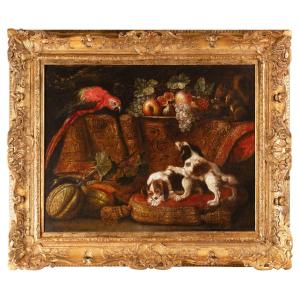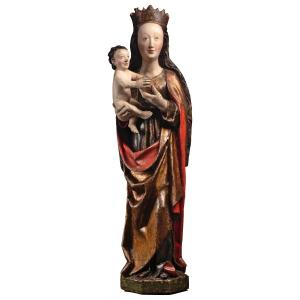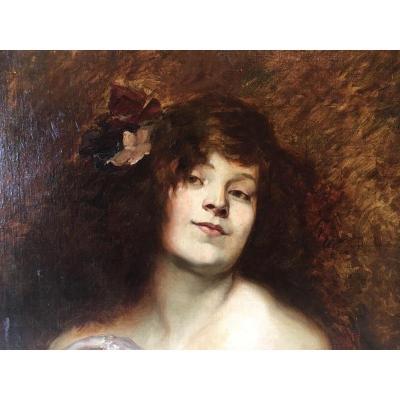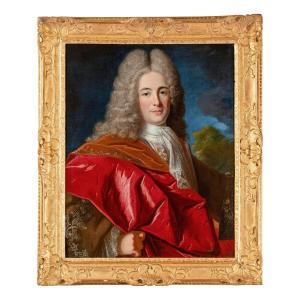Attributed to Jean Baptiste Oudry (1686-1755)
Early 18th century French School, around 1710
Oil on canvas: h. 80 cm, w. 63 cm (31.5 in x 24.8 in)
18th century giltwood carved frame
Framed dimensions: h. 100 cm, w. 83 cm (39.37 in x 32.68 in)
The identity of the sitter is inscribed on the back of its original canvas
The portrait we're offering is emblematic of the reign of Louis XIV, the ceremonial portrait being at its peak among all ranks of the social elite; the composition respects the codes of the ceremonial portrait: the richly dressed and coiffed model, seated, looks confident and serene at the viewer.
Portraited three quarters turned, up to mid-body, the face of the model with determined features is framed by a high powdered wig, the curls of which fall on the shoulders, her neck being decorated with a muslin tie with fine lace .
Brown coat, white satin vest embroidered with gold, a thick crimson velvet coat is thrown over his right shoulder, the tobacco-colored lapel of which is embroidered with silver thread.
The figure of our gentleman with the powerful lighting stands out against the background of a sylvan landscape with a cloudy sky.
This play of contrasts characteristic of Nicolas de Largilliere, master of Jean Baptiste Oudry, is a technique used to highlight the model, revive her complexion, but also intensify the whites and through the contrast obtained make the colors shine in depth.
Related works:
• Portrait of a gentleman, Sotheby's, May 22, 2019, lot no. 82
• Portrait of a war controller at the Palais des Beaux-Arts in Lille, circa 1719, inv P1986
The composition and techniques borrowed from Nicolas de Largilliere direct us towards one of the most brilliant students in his workshop, Jean Baptiste Oudry. Starting his career as a painter thanks to his first training as a portrait painter, Oudry gradually abandoned portraiture in favor of representations of animals, for which he is most recognized today.
Of the hundred portraits that Oudry would have produced during this period, only around fifteen are identified today.
Jean Baptiste Oudry
During the first years of his career, in the 1710s, Oudry first devoted himself to the genre of portrait2. The influence of his master, Nicolas de Largillière, is evident in the treatment of certain figures, as well as in the landscape backgrounds. Oudry also uses certain poses developed in the 17th century by Antoine van Dyck. The artist executes his portraits both in the form of paintings and drawings. He generally works from nature for the face, which he then places on a bust whose pose he freely invents3. Among his portraits, it is possible to cite those of his sons, that of Mr. d'Argenson, police lieutenant, or the Portrait of Tsar Peter I.
From 1713 Oudry established his “book of reason” in which he reproduced in wash, until 1718, all his youthful works. During this first period of approximately 7 years Oudry produced works of great diversity, both in the genres that the artist approached and in the influences that were exerted on him. It is estimated that he painted around 150 paintings during this period: mainly portraits, but also still lifes and some religious paintings and landscapes.
Pierre de La ROCHE (1680-1744), lord of Pertheville, former cavalry officer originally from Lyon, he served in the Dragoon regiment, after the service he settled in Calvados at Pertheville, following the purchase of the stronghold of Pertheville. His brother, Mr Claude Joseph de La Roche, squire, captain of infantry, was receiver of the salt tax and the salt granary of Lisieux.




























 Le Magazine de PROANTIC
Le Magazine de PROANTIC TRÉSORS Magazine
TRÉSORS Magazine Rivista Artiquariato
Rivista Artiquariato
